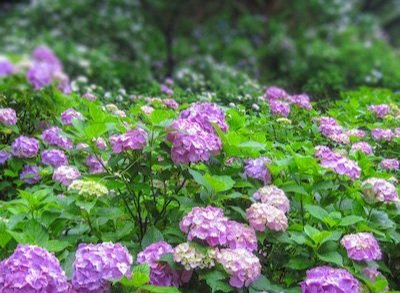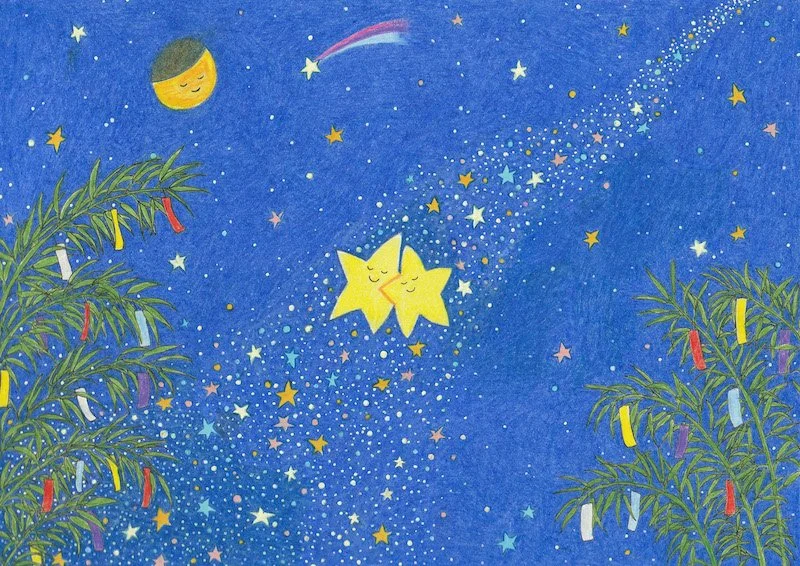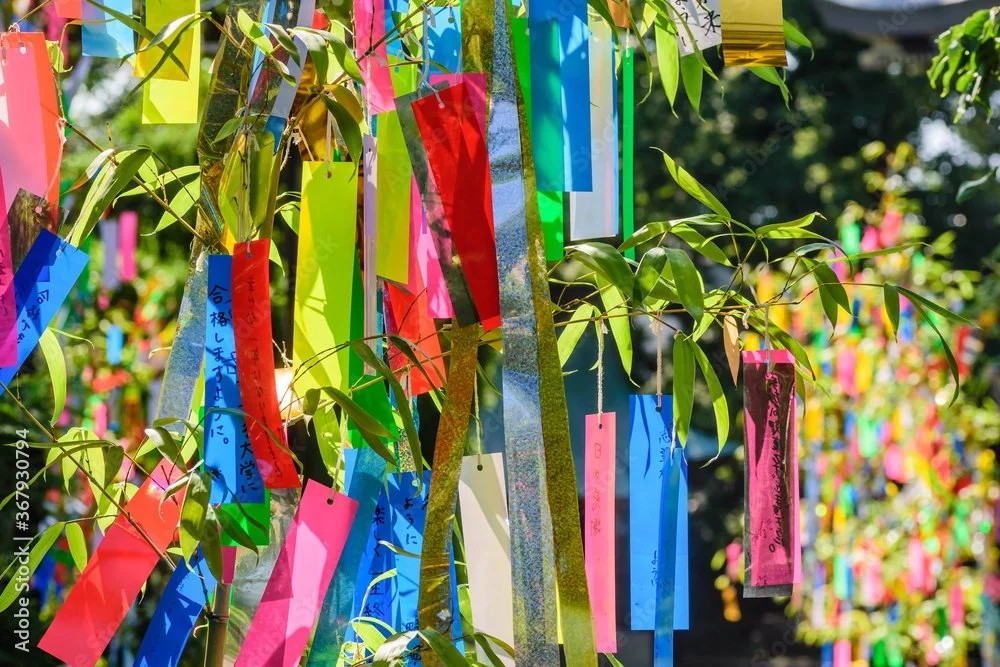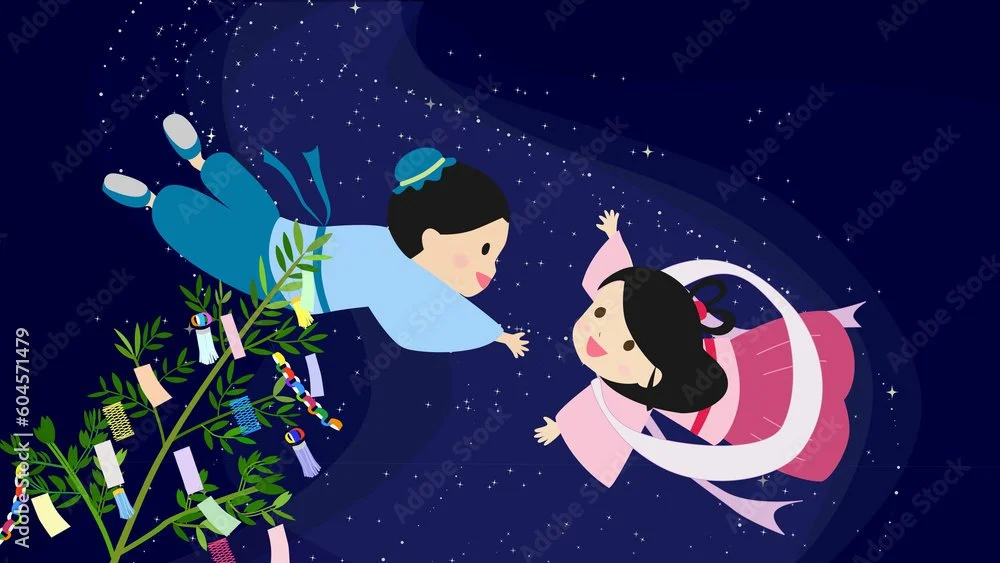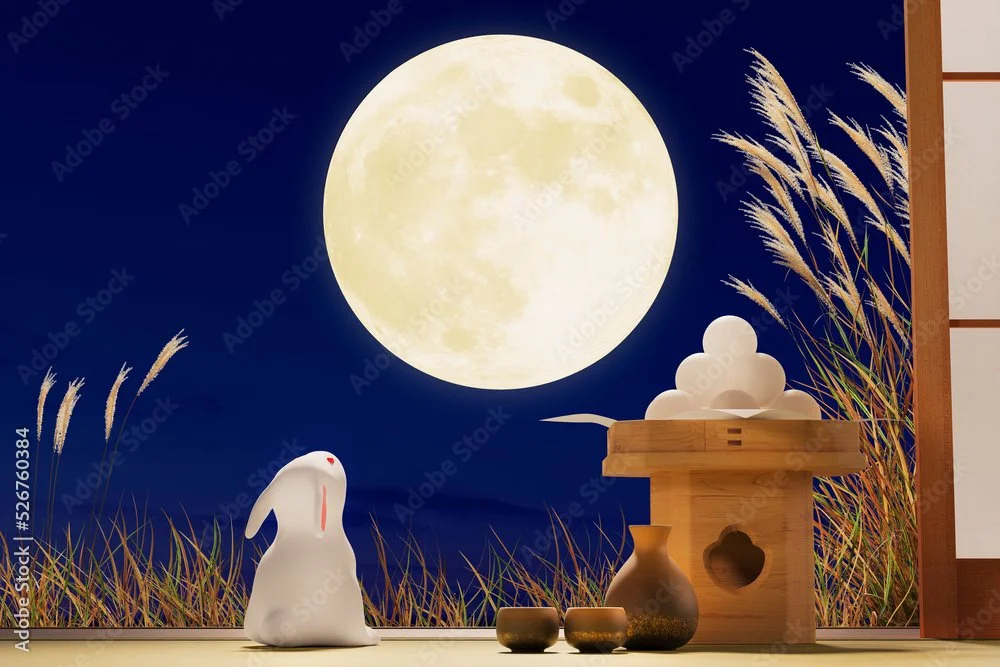Japanese Seasonal event in Calendar 2025
introducing 12 illustrations depicting Japanese seasonal events for the Calendar 2025.
January - New Year’s Day /1月 - お正月
“The main character of the year“「今年の主役」
At the beginning of the New Year in Japan, people decorate their homes with New Year's decorations such as kagami mochi and shōgatsu kazari (New Year's ornaments), eat ozōni (New Year's soup) and osechi ryōri (traditional New Year's dishes), and gather with family and friends. They visit shrines and temples for hatsumōde (the first shrine visit of the year) to pray for health, happiness, and good fortune in the coming year.
2025 is the Year of the Snake in the Chinese zodiac. The illustration for January is a playful depiction of the snake (the lucky white snake, symbolizing good fortune) dressed as kagami mochi, smiling proudly.
新年の始まり、日本では鏡餅や正月飾りなどで飾り付けをして、お雑煮やおせち料理などを食べ、家族や友人などで集まります。神社やお寺に初詣に行き、新年の健康や幸運などを祈願します。
2025年は干支でいうと巳年。1月のイラストは、2025年の干支である蛇(幸運の白蛇)が鏡餅に扮して、得意げに微笑んでいる、遊び心のあるイラストです。
Kagami Mochi / 鏡餅
12 Chinese Zodiac / 十二支
February - Setsubun / 2月 - 節分
”Setsubun Cookies” 「節分クッキー」
Setsubun is a unique Japanese tradition in which people throw roasted soybeans while chanting "Oni wa soto, fuku wa uchi" (Out with the demons, in with the good fortune) to ward off evil. In households and schools, people throw beans at someone dressed as a demon. On Setsubun, people also eat as many beans as their age and Ehōmaki (Sushi roll eaten for good luck).
The illustration for February combines another major February event, Valentine's Day, with the elements of Setsubun. The illustration features the god of good fortune and demons, along with Ehōmaki, all transformed into cute cookies. Even the typically feared demons are portrayed here in a sweet, lovely way, capturing the cheerful Valentine’s Day spirit.
Setsubun in 2025 is February 2nd.
節分は、ユニークな日本の行事で、「鬼は外、福は内」という掛け声と共に、煎った大豆を撒き、厄払いを行います。実際に家庭や学校では、鬼に扮した人に向かって豆を投げるようなイベントも行われています。節分には、年の数だけ豆を食べたり、恵方巻きを食べたりもします。
2月のイラストは、もう一つの2月の大きなイベント、バレンタインデーも掛け合わせて、節分に登場する福の神と鬼、また恵方巻きなどが、可愛らしいクッキーになっています。忌み嫌われる鬼たちもここではバレンタインデーのムードに染まって、スイートでラブリーに描きました。
2025年の節分は、2月2日です。
March - Hina Matsuri / 3月 - ひな祭り
“Love Story” 「ラブストーリー」
Hina Matsuri, or the Doll Festival, is held on March 3rd to celebrate the growth and happiness of girls. During this festival, hina ningyō (dolls) are displayed. These dolls represent the court and aristocratic weddings from the Heian period.
In my home in Japan, we have a hina dan (doll display), but the faces of the dolls are quite serious, and there's not much of a romantic atmosphere. Of course, the eyes of the mebina (female doll) and obina (male doll) never meet.
The illustration was inspired by my wish that, when no one is looking, the dolls might secretly make eye contact and blush. I imagined how cute that would be.
ひな祭りは3月3日に行われる、女の子の成長と幸せを願う行事です。ひな祭りには、雛人形と呼ばれる人形を飾ります。この人形たちは、平安時代の宮廷や貴族の結婚式を模しています。
日本の私の家にも雛壇飾りがありますが、人形の顔はシリアスで、あまりロマンチックな雰囲気はなく、もちろん女雛と男雛の目線が交わることはありません。
人形たちが、見ていないときにこっそりと目を合わせて頬を赤らめていたら可愛いな、という私の願望を元に描いた一枚です。
Hina Dan(Doll Display) / 雛壇
April - Ohanami / 4月 - お花見
“Mt.Fuji and Sakura“ 「富士山と桜」
April is the Sakura(cherry blossom) season in Japan. When the sakura bloom, Japanese people can’t help but go out and enjoy hanami (flower viewing). Whether it’s the early blooms, full bloom, the moment when petals begin to fall, or the leaves starting to show, each stage is beautiful, and everyone has their favorite moment. Personally, I’m moved by the fleeting beauty of the sakura petals falling like rain, a moment so transient that it makes my heart tremble.
Sakura holds a very special place in the hearts of Japanese people, evoking many emotions.
This illustration captures something quintessentially Japanese—a scene with Mount Fuji and sakura. Can there be anything more perfect than this?
4月はお花見シーズンです。桜が咲くと日本人はいてもたってもいられなくなって、お花見に繰り出します。咲き始め、満開、散り際、葉桜、どの瞬間をとっても美しく、それぞれの人に好みの瞬間があります。私は雨のように降る桜吹雪の瞬間が一瞬で儚く心が震えます。
桜は日本人にとってはとても大切な花で、いろいろな思いを呼び起こしてくれます。
こちらは、日本といえばこれ!みたいな一枚です。富士山と桜、これ以上のものがあるでしょうか。
May - Kodomono Hi / 5月 - 子供の日
”Koinobori” 「こいのぼり」
In May, we celebrate Children's Day on May 5th, also known as Tango no Sekku (the Boys' Festival).
In March, during Hina Matsuri, we prayed for the growth and health of girls, but Tango no Sekku is a day to pray for boys. Nowadays, it has become Children's Day and is a day to wish for the health of all children, not just boys.
People celebrate by displaying koi nobori (carp streamers) and kabuto (samurai helmets) and eating kashiwa mochi (oak-leaf-wrapped rice cakes). Since my family only had girls, we didn’t celebrate Children's Day much, but around this time, I can see koi nobori fluttering in the wind everywhere, swimming joyfully in the sky.
While real koi fish swim in the water, I’ve depicted the carp streamers (koi nobori) in this illustration as if they are swimming gracefully in a refreshing flow, blending the feel of both water and wind.
5月には5月5日の子供の日があります。端午の節句とも言います。3月にはひな祭りで女の子の成長と健康を祈りましたが、端午の節句は、男の子の成長と健康を祈ります。現在はこどもの日として、男の子だけでなく全ての子供の健康を願う日となっているようです。
こいのぼりや兜を飾ったり、柏餅を食べたりして祝います。私の家は女の子だけだったので、子供の日のお祝いはあまり経験がありませんが、この頃にはいたるところでこいのぼりが飾られ、空を気持ちよさそうに泳いでいる姿が見られます。
実際の鯉は水の中を泳ぎますが、この絵では水とも風ともどちらとも取れるような描き方で、清々しい流れの中で気持ちよく泳ぐ鯉(こいのぼり)の姿を描きました。
Carp Streamers / こいのぼり
June - Tsuyu / 6月 - 梅雨
“At the window in rainy day” 「ある雨の日の窓辺」
June is the rainy season(Tsuyu) in many parts of Japan. The rainy season usually start in June and continues to July. It’s a time when the rain continues to fall, and the humidity makes it an unpleasant season. However, flowers like ajisai (hydrangeas) bloom beautifully in the rain. The object hanging in the top left is called a teru teru bōzu. It is made of cloth or paper and hung by the window as part of a Japanese tradition, wishing for the rain to stop and for the weather to clear up.
Once the rainy season ends, summer truly begins.
6月は日本の多くの地域で梅雨の時期です。大体6月から7月にかけて雨の季節です。雨が降り続き、ジメジメして嫌な季節ではありますが、紫陽花などの花が雨の中で美しく咲きます。左上に吊るされているのは「てるてる坊主」といいます。布や紙などで作り窓辺に吊るし、雨が上がり晴れることを願う日本の習慣です。
梅雨が明ければ本格的に夏の到来です。
July - Tanabata / 7月 - 七夕
“A tryst“ 「逢瀬」
July 7th is Tanabata, the Star Festival. Tanabata has its origins in a Chinese legend, but the story has changed quite a bit in Japan over time. The version of the story commonly told in Japan today goes like this:
The daughter of the gods, Orihime was a hardworking woman who wove cloth. On the other side of the Amanogawa (the Milky Way), Hikoboshi was also a diligent worker who took care of cattle. The two met, fell in love, and got married. However, they became so engrossed in their love for each other that they stopped working, which angered the gods. As punishment, the gods separated them by placing them on opposite sides of the Milky Way. But seeing how heartbroken they were, the gods allowed them to meet once a year, on the night of Tanabata, as long as they worked hard in the meantime. And so, once a year, on the night of Tanabata, the two cross the Milky Way to meet.
In Japan, for Tanabata, people bring home bamboo trees and hang small pieces of paper called tanzaku on the bamboo leaves, writing their wishes on them. They also decorate the bamboo with paper ornaments and other decorations.
The stars shining on both sides of the Milky Way, Vega represents Orihime, and Altair represents Hikoboshi. In the illustration, I’ve depicted Orihime and Hikoboshi as two shining stars crossing the Milky Way, side by side.
7月7日は七夕です。七夕は中国の説話が起源ですが、だいぶお話の内容は元々の話と変わっています。日本で現代語られているお話はこんな感じです。
神様の娘である織姫は、機織りが仕事の働き者。天の川の向こう岸に住んでいる彦星は同じく働き者の牛飼いです。二人は出会い恋に落ち、結婚しました。ところが二人は恋に夢中になって働かなくなってしまい、神様を怒らせてしまいます。神様は二人を天の川の両岸に引き離しました。しかし、悲しみに暮れる二人を見た神様は、真面目に働くのならば七夕の夜にだけに会っても良いとします。そうして再び真面目に働くようになった二人は、一年に一度七夕の夜、天の川を渡って会うのです。
日本では、七夕には、竹の木を持ってきて、笹の葉に願い事を書いた短冊や、紙で作った七夕飾りなどを吊します。
天の川の両側に光る星、ベガが織姫、アルタイルが彦星と言われています。イラストは、織姫と彦星を、天の川を渡り寄り添う二つの輝く星として描きました。
August - Natsuyasumi / 8月 - 夏休み
”Children of the sun” 「太陽の子供達」
In Japan, August is the summer vacation season (Natsuyasumi). Sunflowers bloom under a clear bright summer sky with cumulus clouds. Children excitedly ask, "Where shall we go? The mountains, the river, or the sea?"
日本で8月は、夏休みのシーズンです。ひまわりが咲き、入道雲にピカーっと晴れた夏の日。スイカを頬張りながら、山に川に海に、どこに行く!?とワクワクの子供達です。
September - Otsukimi / 9月 - お月見
“Rabbit Astronauts“ 「ウサギの宇宙飛行士」
Otsukimi is a tradition of moon viewing held on the 15th day of the 8th month of the lunar calendar. It is also known as the Chūshū no Meigetsu (Mid-Autumn Moon) or Jūgoya (Fifteenth Night). The date of Otsukimi changes each year and usually in September, but in 2025, it will be on October 9th.
There is a tradition of offering tsukimi dango (rice dumplings) and decorating with susuki (Japanese pampas grass), but it’s believed that very few people actually observe Otsukimi today. However, the theme of Otsukimi is still frequently used in various motifs. The pattern on the moon is often said to resemble a rabbit making rice cakes, which is why rabbits are often depicted with Otsukimi.
In the illustration, I’ve added a twist to the tradition, showing rabbits as an astronaut, flying to the moon and offering Tsukimi dango directly to the moon.
お月見は、旧暦の8月15日に当たる日に、満月を鑑賞する行事です。中秋の名月、十五夜なども言われます。毎年お月見の日にちは変動し、9月になることが多いですが、2025年は10月9日となります。
お月見だんごをお供えしたり、ススキを飾ったり、という習慣がありますが、実際にお月見を行なっている家庭は現在はごく少ないと思われます。しかし今もモチーフとしてお月見はよく使用されています。月の模様がウサギが餅つきをしているように見えるなどのことから、お月見にウサギが描かれることも多いです。
イラストでは、ウサギがなんと宇宙飛行士(?)になって月まで飛んで、直接月見団子を備えているという、少しひねりを効かしてお月見を描いています。
October - Halloween / 10月 - ハロウィン
“Trick or Treat!“ 「トリックオアトリート!」
Halloween has become a popular event in Japan in recent years. While there is no tradition of going door to door for trick-or-treating, people enjoy dressing up in costumes and participating in parades, making it an exciting event for both children and adults.
In the illustration, I’ve scattered a variety of Japanese sweets. Can you guess what they are?
ハロウィンは日本でも近年行われている行事です。トリックオアトリートで近所の家々を回る習慣はありませんが、仮装してパレードに参加したり、子供も大人も楽しむ盛り上がるイベントとなっています。イラストには日本のお菓子をたくさん散りばめました。なんのお菓子か分かるかな?
November - Colored leaves / 11月 - 紅葉
“Fallen Leaves” 「落ち葉」
Autumn is the season of colorful leaves and fallen foliage. People go out to enjoy the vibrant colors of trees like maple and ginkgo.
秋は紅葉と落ち葉のシーズンです。モミジや銀杏など、鮮やかに色づいた木々を愛でに出かけます。
December - Christmas / 12月 - クリスマス
“The Blessings of the Angels” 「天使たちの祝福」
December is Christmas time. In Japan, even people who are not Christian celebrate Christmas. The main events are Santa Claus, Christmas decorations, christmas presents, festive meals and christmas cake with family or your partner! The streets twinkle with holiday illuminations, creating a cheerful and beautiful atmosphere.
In the illustration, small angels are gathering around the Christmas tree. Each angel is doing something different, so take a look at each one and see what they are doing!
12月はクリスマス。日本ではキリスト教徒でなくても、クリスマスをお祝いします。ただそこにはあまり宗教色はなく、サンタさんや、クリスマスの飾りつけ、クリスマスプレゼントや、家族、恋人とのご馳走がメインイベントとなっています。街はイルミネーションでキラキラとして、美しくウキウキする季節です。
12月のイラストでは、小さな天使たちが、クリスマスツリーに集まってきている様子。色々なことをしているので、それぞれの天使に注目してみてください。














